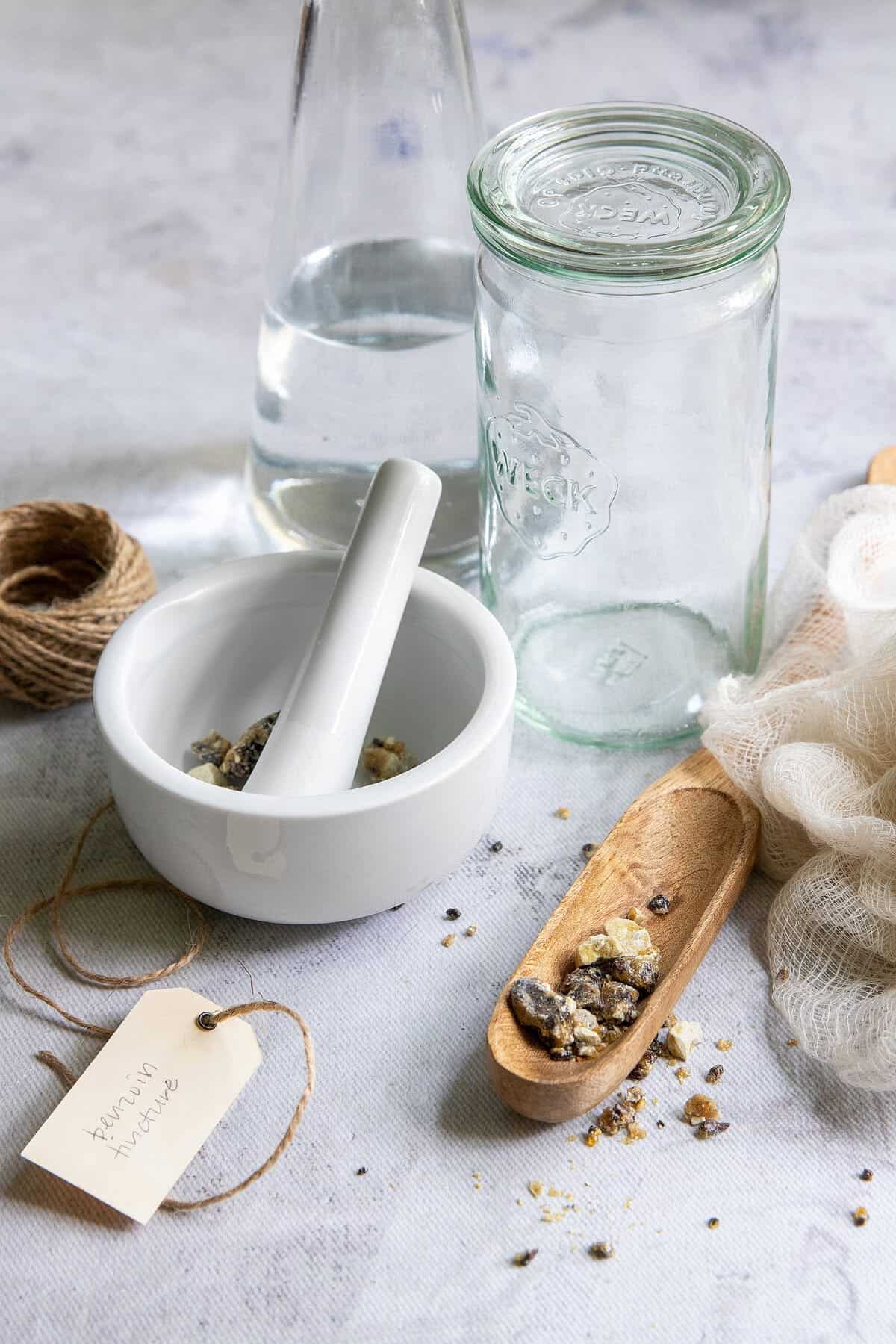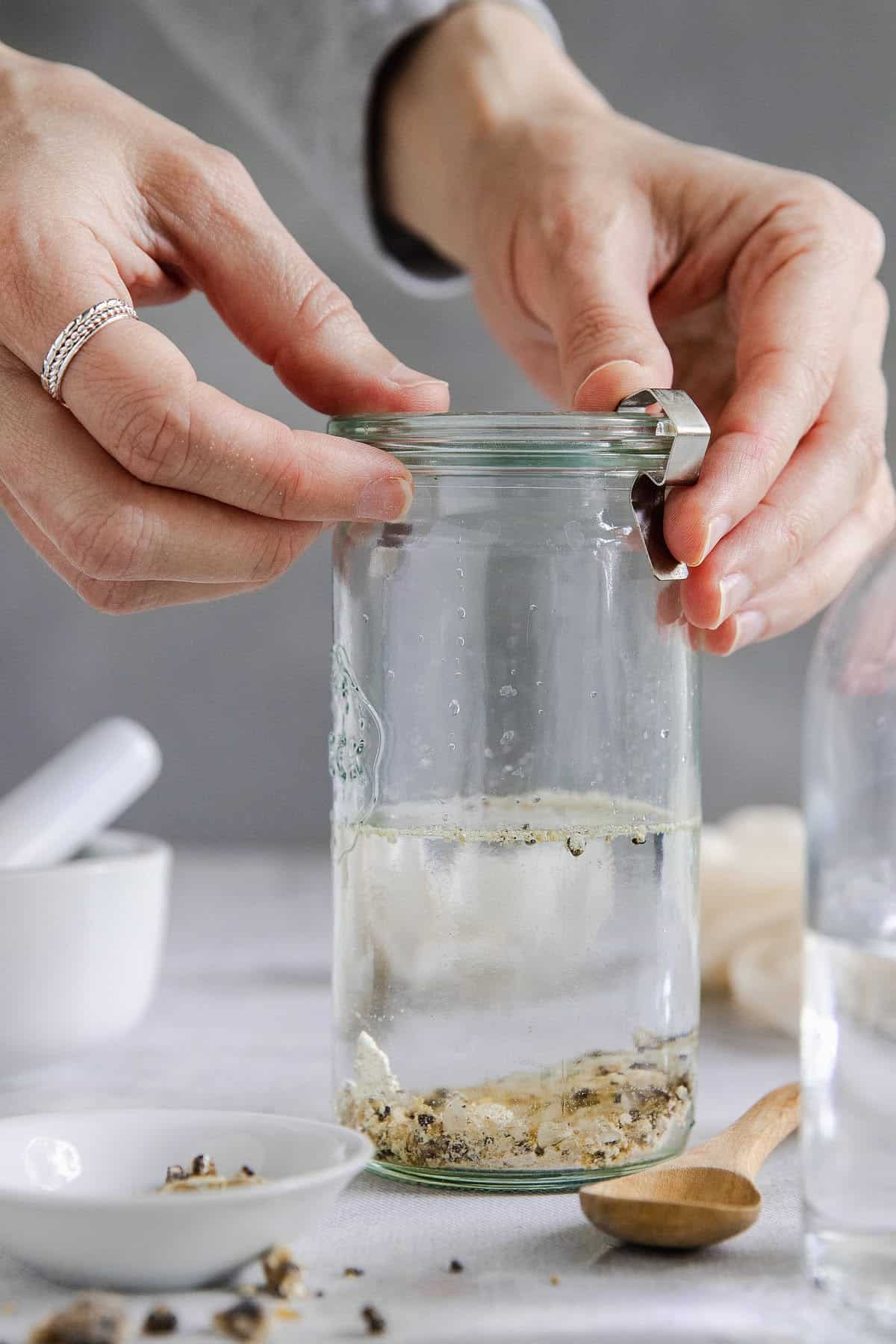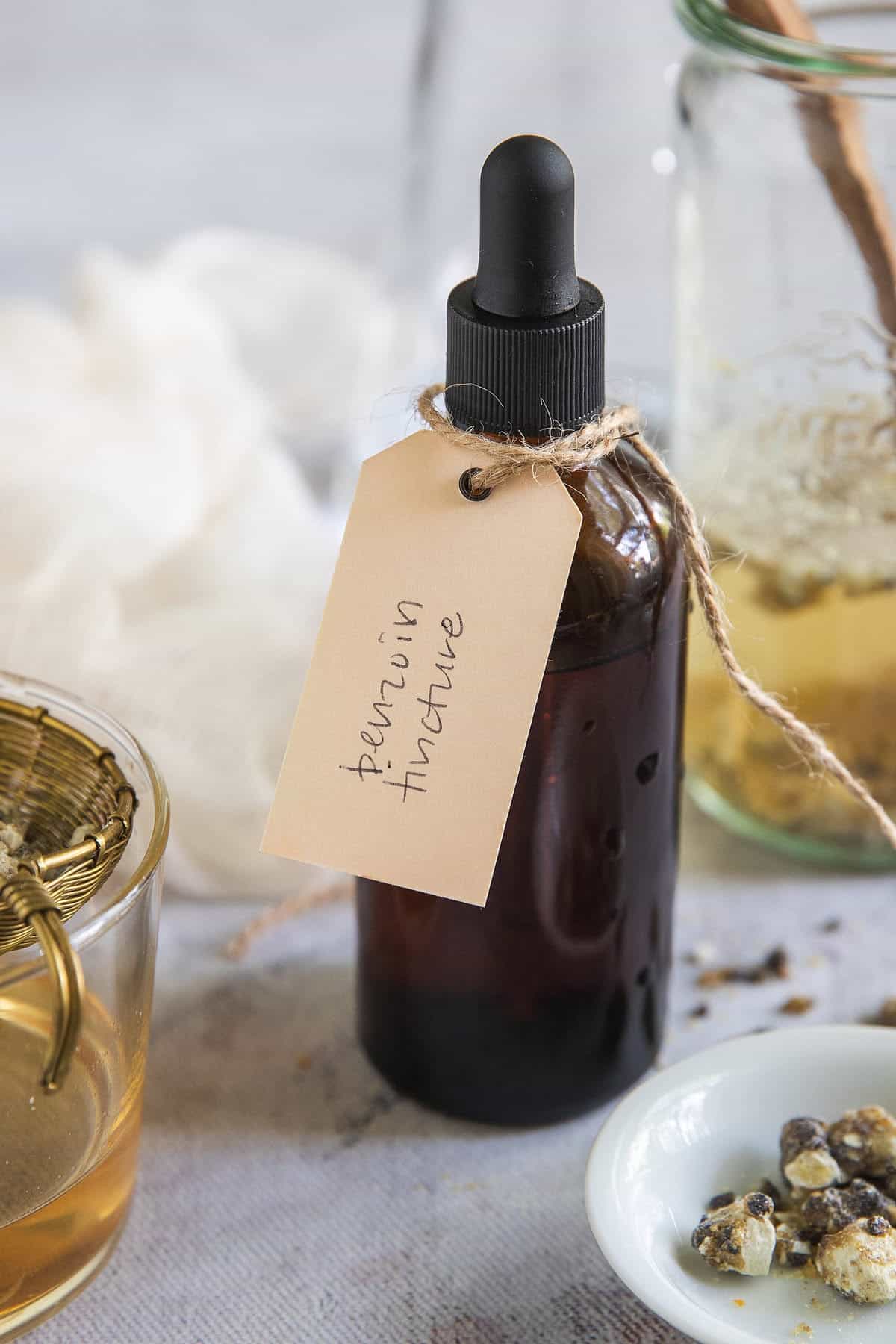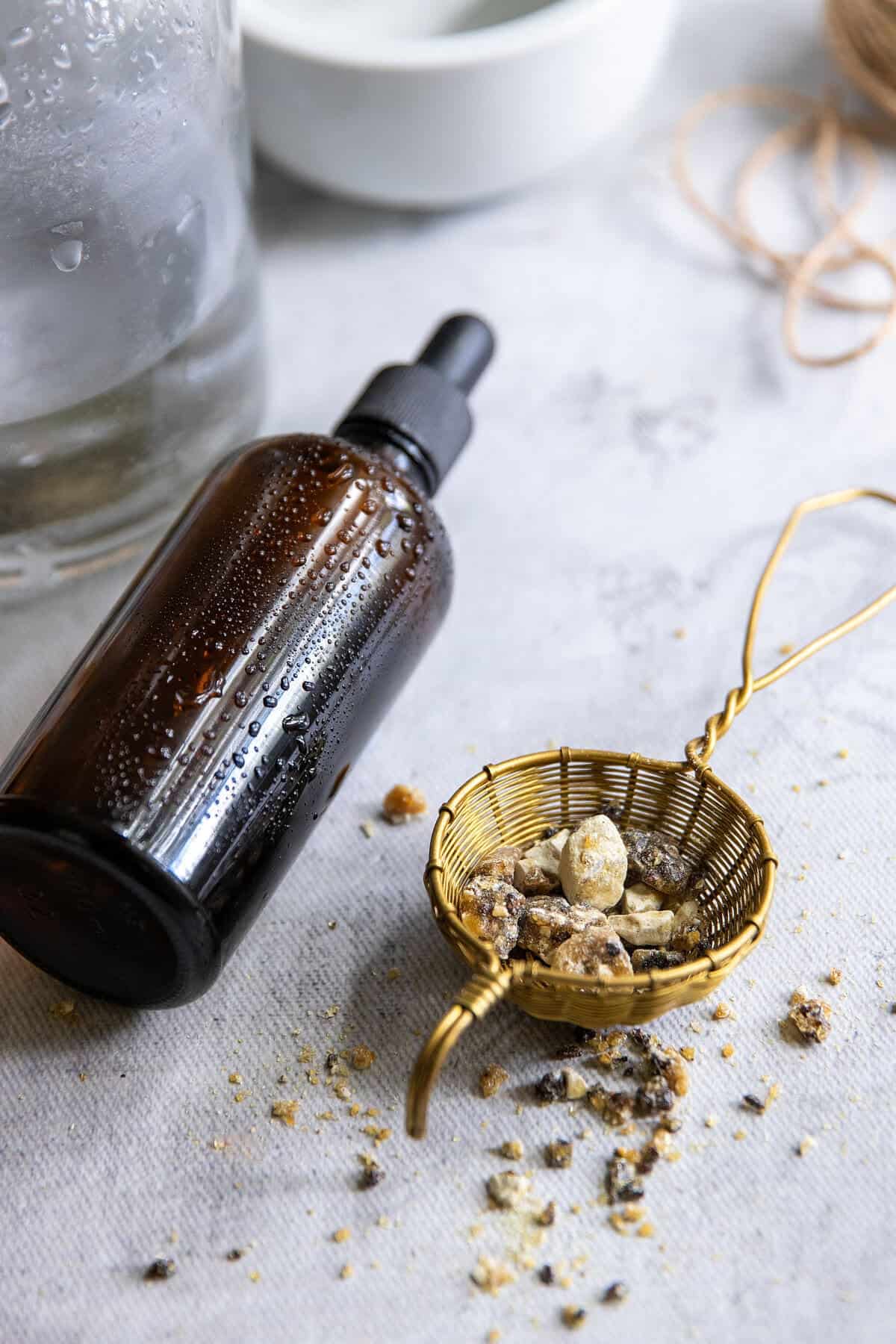[ad_1]
In the aromatic world of homemade perfumes tincture of Benzoin is a key ingredient that can transform your DIY perfume into a masterpiece of lingering scents. With its rich, warm, and vanilla-like aroma, Benzoin serves not only as a lovely base note but also as a superb fixative to enhance the longevity and depth of your fragrance.
Whether you’re a seasoned perfumer or a curious beginner, making your own Benzoin tincture is a simple but rewarding project. Learn how to harness the sweet, balsamic notes of Benzoin to craft perfumes that are uniquely yours, evoking a sense of warmth and luxury.
Here’s a simplified overview of how you can make your own tincture of Benzoin and how to use it!
Jump to:
What Is Benzoin?
Benzoin is an aromatic resin obtained from the bark of several species of trees in Southeast Asia. The resin is collected by making incisions in the tree’s trunk allowing sap to seep out. It hardens when exposed to air and sunlight and is then harvested.
Benzoin Uses
Traditionally, benzoin has been used in herbal medicine for its antiseptic, anti-inflammatory, and astringent properties. It’s often used in healing balms and lotions to treat skin irritations.
Benzoin resin has a distinctive sweet, warm scent with vanilla-like undertones. Its rich, comforting aroma makes it a favored base note in many oriental and floral fragrances.
Benzoin is also used as a fixative, helping to stabilize more volatile fragrance notes and extend the longevity of perfume on the skin.
How To Make Tincture of Benzoin
Making your own tinctures is a pretty simple process that uses alcohol to extract beneficial plant elements. To make a tincture of benzoin we’re going to dissolve benzoin resin in alcohol so that it can be used in homemade perfume recipes.
Ingredients and Materials


- 1 part Benzoin resin
- 5 parts high-proof ethyl alcohol (such as 95% ethanol)
- Glass jar with a tight-fitting lid
- Cheesecloth or coffee filter
- Glass bottle for storage
Instructions


Step 1: Prepare Benzoin Resin
Break the benzoin resin into small pieces to increase its surface area, which will help it dissolve more easily in the alcohol.


Step 2: Mix with Alcohol
Place the resin pieces into a glass jar. Pour enough alcohol over the resin to cover it completely. The typical ratio is about 1 part benzoin to 5 parts alcohol.


Step 3: Seal and Store
Close the jar tightly and store it in a cool, dark place. The mixture needs to sit for several weeks; shaking the jar occasionally can help dissolve the resin into the alcohol.


Step 4: Strain the Mixture
After the resin has dissolved (partially or fully), strain the liquid through cheesecloth or a coffee filter to remove any undissolved solids. Transfer the strained tincture into a clean, glass bottle.
Storage


Label your tincture bottle with the contents and the date then store it in a cool, dark place to prevent evaporation and degradation of the aromatic properties. It has a long shelf life if kept sealed and away from direct sunlight.
While you can use the tincture as soon as it is strained, allowing the tincture to age for several weeks or even months can enhance its fragrance as the components meld and mature.
Safety Note: Some people may be sensitive or allergic to benzoin and its tincture. You definitely want to do a small test patch first to make sure you don’t have adverse reactions.
How To Use Tincture of Benzoin in Perfume Making


This tincture is a valuable ingredient in making perfume, acting primarily as a fixative and base note. Its warm, vanilla-like, sweet, and somewhat balsamic fragrance adds depth and richness to perfumes.
Here’s how it’s used in creating perfume recipes:
As a Fixative
- Stabilizes Volatile Components: Benzoin’s heavy molecular weight helps it act as a fixative by slowing the evaporation rates of the more volatile, lighter top notes in a perfume.
- Enhances Scent Longevity: By anchoring the lighter notes, benzoin extends the overall longevity of the perfume, making the fragrance last longer on your skin and in the air.
As a Base Note
- Contributes to the Fragrance Profile: Benzoin adds a rich, warm, and comforting note that is particularly sought after in oriental and woody fragrances. Its vanilla-like undertone provides a sweet base that can round off sharper notes and add complexity.
- Blending: Benzoin blends well with a variety of scents, including rose, jasmine, frankincense, sandalwood, and citrus oils. It is especially popular in oriental, woody, and amber fragrances.
Benzoin Perfume Formulations
Here are a few perfume formula ideas that incorporate benzoin. The percentages represent the proportion of each component in the fragrance concentrate, which then needs to be diluted in a perfumer’s alcohol base to make the final product, typically making up about 10-20% of the total volume.
1. Oriental Vanilla Perfume
- Top notes: Bergamot (1%), Mandarin Orange (2%)
- Middle notes: Jasmine (2%), Rose (3%)
- Base notes: Benzoin (10%), Vanilla (5%), Patchouli (3%), Musk (2%)
This formula starts with fresh, citrus top notes that transition into a floral heart, grounded by a deep, warm oriental base featuring benzoin and vanilla. The benzoin not only fixes the lighter notes but also complements the vanilla’s sweetness, creating a lush, enduring scent.
2. Woody Amber Perfume
- Top notes: Black Pepper (1%), Cardamom (1.5%)
- Middle notes: Iris (3%), Cedarwood (4%)
- Base notes: Benzoin (8%), Amber (5%), Sandalwood (4%), Vetiver (2%)
In this composition, spicy top notes lead to a woody and slightly floral middle, settling into a rich amber and benzoin base. This combination is perfect for those who prefer a deep, resinous, and slightly earthy fragrance.
3. Floral Oriental Perfume
- Top notes: Lemon (2%), Lavender (1%)
- Middle notes: Orchid (3%), Geranium (2%)
- Base notes: Benzoin (9%), Myrrh (3%), Frankincense (2%)
This blend offers a complex bouquet of floral and oriental notes. The lemon and lavender provide a refreshing opening, while the heart features exotic florals. The base of benzoin, myrrh, and frankincense adds a mystical, incense-like depth, suitable for a sophisticated and mysterious scent profile.
4. Modern Chypre Perfume
- Top notes: Grapefruit (2%), Orange (2%)
- Middle notes: Rose (3%), Peony (2%)
- Base notes: Benzoin (7%), Oakmoss (3%), Musk (3%), Patchouli (2%)
A modern take on the classic chypre structure, this formula uses citrus to introduce a floral heart, anchored by a complex base where benzoin’s sweet resinous notes are balanced by the earthiness of oakmoss and musk.
5. Simple Balsamic Vanilla Perfume
- Top notes: Orange (3%)
- Middle notes: Cinnamon (2%)
- Base notes: Benzoin (15%), Vanilla (10%)
This simple yet powerful formula focuses on balsamic and vanilla notes, with benzoin providing richness and depth, supported by the spicy warmth of cinnamon. It’s designed for vanilla lovers who appreciate a resinous twist to the sweetness.
FAQ
Benzoin is typically used as a base note and fixative in perfumes. It adds a rich, vanilla-like scent and helps stabilize more volatile notes, extending the longevity of the fragrance on the skin.
The concentration can vary widely, but typically benzoin makes up a small percentage of the total formulation, often between 5% and 20% of the fragrance concentrate, depending on the desired strength and effect.
The soaking period can range from a few weeks to several months, depending on the desired strength and solubility. Shaking the mixture occasionally can help to dissolve the resin more completely.
[ad_2]
Source link
